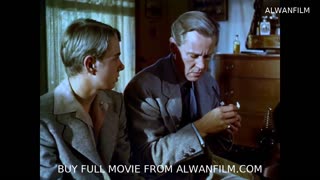Premium Only Content

The Colossus of New York Colorized
The Colossus of New York Colorized
Review: The Colossus of New York 1958 Colorized - Exploring the Impact of Early Colorization
Introduction
"The Colossus of New York 1958" stands as a captivating blend of science fiction and horror, capturing the imagination of audiences with its chilling narrative and groundbreaking visuals. Directed by Eugène Lourié, this film explores the consequences of human ambition and the ethical dilemmas of scientific advancement. In this article, we will delve into the significance of the film's early colorized version and its impact on the viewing experience of "The Colossus of New York 1958," while discussing its place in the broader context of film history.
Check The Full Colorized Movies List
Check Our YouTube Channel
Check Our Colorized Movies Trailer Channel
Understanding The Colossus of New York 1958 Colorized: Director, Cast, and Genre
"The Colossus of New York 1958" is the brainchild of Eugène Lourié, a director renowned for his work in the science fiction genre. Lourié's vision for the film intertwines the macabre with the technologically sublime, creating a narrative that is as thought-provoking as it is eerie. The film stars Ross Martin as Jeremy Spensser, the brilliant scientist whose tragic fate sets the story in motion. The cast also includes Otto Kruger as Dr. William Spensser and Mala Powers as Anne Spensser, each delivering performances that anchor the film's emotional core.
Lourié's direction in "The Colossus of New York 1958" masterfully balances elements of horror and science fiction, crafting a genre hybrid that explores the darker facets of technological progress. The film's unsettling atmosphere and moral quandaries resonate with audiences, inviting them to ponder the ethical boundaries of scientific discovery.
Exploring the World of The Colossus of New York 1958 Colorized: Plot and Characters
At the heart of "The Colossus of New York 1958" lies a compelling tale of grief, ambition, and unintended consequences. The plot centers on Jeremy Spensser, a brilliant scientist who meets an untimely death. In an attempt to preserve his intellect, Jeremy's father, Dr. William Spensser, transplants his brain into a towering robot, creating the titular "Colossus."
As Jeremy navigates his new existence as a mechanical giant, he grapples with his loss of humanity and the isolation that accompanies his transformation. The film delves into the psychological and emotional turmoil of its protagonist, exploring themes of identity, loss, and the ethical ramifications of playing god.
The Art of Film Colorization
Film colorization, the process of adding color to black and white footage, has long been a topic of debate within the cinematic community. Advocates argue that colorization revitalizes classic films for contemporary audiences, while critics contend that it compromises the original artistic vision and historical authenticity.
The art of colorization involves a meticulous process of digitally painting frames, ensuring that the colors align with the film's tone and atmosphere. When executed with care, colorization can enhance the visual experience, providing a fresh perspective on familiar narratives. However, it also poses the risk of altering the film's aesthetic integrity and diminishing its original impact.
Early Colored Films: A Brief History
The advent of early colored techniques in cinema marked a significant milestone in the industry's evolution, expanding the possibilities of visual storytelling. From hand-painted frames in the silent era to the advent of Technicolor in the 1930s, filmmakers have continuously experimented with color to enhance their narratives.
Early colored films offered audiences a new dimension of visual splendor, transforming the cinematic experience. However, these innovations also came with challenges, including high production costs and technical limitations. Despite these obstacles, early colorization techniques laid the groundwork for future advancements, paving the way for modern color cinema.
The Colossus of New York 1958 and Its Early Colored Version
The decision to release "The Colossus of New York 1958" in a colorized format represents a bold artistic choice, inviting audiences to re-experience the film's chilling narrative through a new visual lens. While some may view this as a departure from the film's original aesthetic, others appreciate the opportunity to see the story in a different light.
The early colored version of "The Colossus of New York 1958" enhances the film's atmospheric tension, adding vibrancy and depth to its stark visuals. The colorization process highlights the film's dramatic contrasts, from the eerie glow of the Colossus's eyes to the muted tones of the laboratory scenes. This reinterpretation offers a fresh perspective on Lourié's visual storytelling, enriching the film's narrative complexity.
The Debate Over Film Colorization
As with any controversial artistic endeavor, the colorization of classic films sparks heated debates within the film community. While some argue for preservation and fidelity to the director's original vision, others advocate for creative experimentation and making classic films more accessible to modern audiences. Ultimately, the debate underscores the complex interplay between tradition and innovation in cinema.
Critics of film colorization argue that altering a film's original black and white imagery can compromise its artistic integrity and historical significance. They contend that the monochromatic palette is integral to the film's mood and thematic resonance. On the other hand, proponents of colorization argue that it can breathe new life into classic films, making them more appealing and relatable to contemporary viewers.
Examining The Colossus of New York 1958 as an Early Colored Film
Viewing "The Colossus of New York 1958" in its early colored version offers a unique opportunity to re-evaluate Lourié's directorial choices and the film's visual impact. The addition of color enhances the film's eerie atmosphere, emphasizing the stark contrasts between the human characters and the mechanical Colossus.
For some viewers, the colorized version may enhance their appreciation of the film's narrative and visual storytelling, providing a fresh interpretation of its themes and motifs. For others, it may detract from the film's original aesthetic and emotional impact, obscuring the stark beauty of its black and white imagery. Ultimately, the decision to embrace or reject colorization is a matter of personal preference, reflecting the diverse perspectives within the cinematic community.
Influence and Legacy: The Colossus of New York 1958 Colorized's Impact on Cinema
"The Colossus of New York 1958" has left an indelible mark on the science fiction genre, inspiring subsequent filmmakers to explore similar themes of technological ambition and ethical dilemmas. Its influence can be seen in a range of films that grapple with the consequences of human innovation and the boundaries of scientific progress.
The film's exploration of the ethical ramifications of scientific experimentation resonates with contemporary audiences, highlighting the timeless relevance of its themes. Its legacy endures through its impact on subsequent science fiction narratives, serving as a touchstone for filmmakers exploring the darker facets of technological advancement.
Director's Cinematic Legacy: Beyond The Colossus of New York 1958 Colorized
Eugène Lourié's cinematic legacy extends beyond "The Colossus of New York 1958," encompassing a diverse body of work that spans multiple genres. Lourié's films reflect his deep understanding of visual storytelling and his ability to create compelling narratives that resonate with audiences.
From his work on classic monster films like "The Beast from 20,000 Fathoms" to his contributions to the science fiction genre, Lourié's films continue to captivate and inspire. His ability to blend visual spectacle with thought-provoking themes has cemented his status as a visionary director whose influence extends across decades of cinematic history.
Themes Explored in The Colossus of New York 1958 Colorized
At its core, "The Colossus of New York 1958" grapples with themes of ambition, identity, and the ethical boundaries of scientific progress. The film's exploration of these themes is both chilling and poignant, inviting viewers to contemplate the consequences of human innovation and the price of playing god.
The narrative delves into the psychological and emotional turmoil of its protagonist, Jeremy Spensser, as he grapples with his transformation from human to mechanical giant. The film's exploration of identity and loss resonates with audiences, highlighting the profound impact of technological advancement on the human experience.
Reception and Controversy Surrounding The Colossus of New York 1958 Colorized
The release of "The Colossus of New York 1958" in its early colored version has sparked both acclaim and controversy among critics and audiences. While some praise the enhanced visual experience, others lament the departure from the film's original aesthetic. Nevertheless, the debate underscores the enduring relevance of Lourié's masterpiece in contemporary discourse.
Critics have praised the film's visual beauty, thematic richness, and emotional resonance, hailing it as a towering achievement in science fiction cinema. However, others have raised concerns about the impact of colorization on the film's integrity, arguing that it detracts from Lourié's original vision and diminishes the film's historical significance.
Where to Watch The Colossus of New York 1958 Colorized Online
For those eager to experience the timeless brilliance of "The Colossus of New York 1958," the film is available on various streaming platforms, ensuring accessibility to audiences worldwide. Whether in its original black and white format or the early colored rendition, Lourié's opus remains essential viewing for cinephiles and newcomers alike.
FAQs About The Colossus of New York 1958 Colorized
Common queries surrounding "The Colossus of New York 1958" range from its historical accuracy to its thematic resonance in modern times. By addressing these frequently asked questions, viewers can gain a deeper understanding of the film's enduring appeal and cultural significance.
Q: Is "The Colossus of New York 1958" historically accurate?
A: While the film is rooted in speculative science fiction, it does not aim for historical accuracy. Instead, it uses its narrative to explore ethical and philosophical questions about human ambition and technological progress.
Q: What is the significance of the film's title?
A: The title "The Colossus of New York 1958" refers to the protagonist, Jeremy Spensser, who becomes a towering mechanical giant. The title also reflects the film's exploration of the monumental consequences of scientific experimentation.
Q: What is the symbolism of the film's imagery?
A: The imagery in "The Colossus of New York 1958" is rich with symbolism, reflecting the film's themes of identity, loss, and the ethical boundaries of scientific progress. The mechanical Colossus serves as a metaphor for the dehumanizing effects of technological advancement and the isolation that accompanies it.
Conclusion
In conclusion, "The Colossus of New York 1958" stands as a landmark achievement in science fiction cinema, its legacy enduring through the ages. While the early colored version offers a fresh perspective on Lourié's masterwork, purists may still prefer the original black and white presentation. Regardless of personal preference, one thing remains clear: the power of "The Colossus of New York 1958" lies not in its color palette, but in its profound exploration of the human spirit and the ethical dilemmas of scientific progress. As we continue to grapple with the ever-evolving landscape of cinema, let us heed the lessons of Lourié's masterpiece and strive to honor his visionary legacy for generations to come.
-
 1:00
1:00
AlwanFilm
1 day agoIntruder in the Dust 1949 Colorized
15 -
 28:10
28:10
Tactical Advisor
1 hour agoKuna FIRST LOOK | Vault Room LIve Stream 020
9.86K2 -
 44:41
44:41
Coin Stories with Natalie Brunell
6 hours agoBeating the Odds with Bitcoin: John Deaton’s Path To Prosperity & Reviving the American Dream
31.1K3 -
 1:17:40
1:17:40
Awaken With JP
4 hours agoLeft Wonders if Killing is Wrong? - LIES Ep 87
65.5K78 -
 2:15:01
2:15:01
The Quartering
5 hours agoChina PANICS Over Tariffs, Tesla Terrorist Gets 40 Years, TikTok Challenge KILLS 8 Year Old & More
160K43 -
 1:48:41
1:48:41
Right Side Broadcasting Network
6 hours agoLIVE: President Trump at Commander-in-Chief Trophy Presentation to the Navy Midshipmen - 4/15/25
67.5K5 -
 1:16:30
1:16:30
The HotSeat
3 hours agoJoe Biden Crawls Out of the Basement, Meanwhile AOC Cosplays Kamala
36.4K6 -
 9:25
9:25
Talk Nerdy Sports - The Ultimate Sports Betting Podcast
2 hours ago4/15/25 - Solo Mission: Play-In Carnage & Diamond Sniping
22.3K1 -
 1:11:07
1:11:07
Jeff Ahern
3 hours ago $0.89 earnedTrending Tuesday with Jeff Ahern!
23.2K3 -
![[Ep 650] Left Victimizes Karmelo Anthony | Defund NPR/PBS | Guest Sam Anthony [your]NEWS](https://1a-1791.com/video/fww1/46/s8/1/1/X/o/C/1XoCy.0kob.1-small-Ep-650-Left-Victimizes-Karm.jpg) 2:11:04
2:11:04
The Nunn Report - w/ Dan Nunn
3 hours ago[Ep 650] Left Victimizes Karmelo Anthony | Defund NPR/PBS | Guest Sam Anthony [your]NEWS
18.4K11